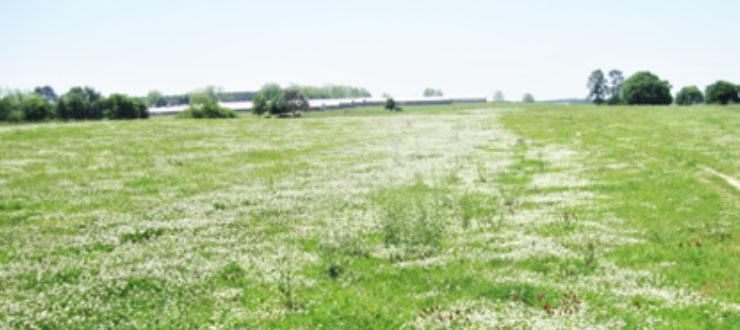
Benefits of legumes or legume/grass mixtures can include biological nitrogen fixation, higher forage yield, more favorable distribution of forage growth, and higher forage quality that results in better animal performance. In pasture situations, clovers are by far the most commonly used type of forage legume.
Depending on climatic conditions, soils, and sites, a livestock producer may grow a perennial clover or an annual clover. The most commonly grown perennial clovers are red clover (plants usually live for 2 to 3 years) and white or ladino clover (plants commonly live for 3 years or longer). These clovers are most commonly grown with cool-season perennial grasses such as tall fescue or orchardgrass, but may sometimes be a companion species to warm-season perennial grasses, especially dallisgrass.
In areas where perennial clover won’t live for more than one year, annual clovers including arrowleaf clover, berseem clover, balansa clover, or crimson clover can be used. Annual clovers are often grown with annual ryegrass and/or a small grain and may be planted on a prepared seedbed or overseeded on the sod of a warm-season perennial grass such as bermudagrass, bahiagrass, or dallisgrass.
One of the most common questions pertaining to pasture management is, “What are my options for controlling or discouraging weeds in clovers or other legumes?” This is a practical and important question because clovers are sensitive plants that are damaged or killed by most pasture herbicides. There are numerous clover species and many weed species, so addressing every weed/clover scenario is not possible here, but basic strategies are as follows.
Keep Forage Plants Competitive.
A thin forage stand provides an environment that is more favorable for weed seed germination and weed growth. Thus, management practices such as applying soil amendments (fertilizer and lime) as needed, and avoiding overgrazing favor health and vigor of forage plants, which greatly reduces weed problems.
Kill Weeds, Then Plant Clover.
Preventing weeds from making seeds in a field a year or more before planting clover can be helpful. When a pasture is tilled in preparation for planting, it may be helpful to allow weed seed to germinate, after which the weed seedlings can be killed with tillage or with a herbicide, followed by planting clover.
Use A Herbicide.
Unfortunately, few herbicides labeled for use on established pastures will selectively kill weeds without killing clover. In a situation in which there is no selective herbicide option, but weeds are taller than clover, it may be possible to use a rotary wiper set at a height such that it applies herbicide only to weeds.
Time Herbicide Application.
Sometimes, the timing of a herbicide application will determine how much impact it will have on clover. A good example is a crimson clover overseeded on a warm-season perennial grass sod. Some herbicides can be applied after the clover has mature seed in the seedheads (around mid-May in most of the South), with the result being that broadleaf weeds can be killed, but a reseeded crimson clover stand can potentially come back the next autumn. This concept applies to a number of other annual or perennial clovers in certain situations.
Grazing Management.
Cattle generally prefer to consume clover foliage rather than weed foliage, which gives weeds a competitive edge. As grazing management is intensified and stocking rates are increased, animals are forced to eat weeds as well as clovers and grasses. When animals are removed from the paddock, the clovers can re-grow without being grazed, thus taking away the competitive edge weeds would otherwise have. Many weeds are quite sensitive to being grazed. Furthermore, when weeds are grazed, they make little or no seed, thus reducing weed problems in the future. Cattle won’t eat some weeds such as dewberry, blackberry, and greenbrier. However, goats will eat these weeds, so where feasible, the addition of a few goats to a pasture may be desirable.
Clipping.
Most clovers are shorter than many weeds, so a mower can be set to cut at a height that will cut off the top part of the weeds, without cutting the clover. This usually doesn’t kill weeds, but it generally makes them somewhat less competitive and reduces shading of clovers In addition, clipping can reduce or eliminate seed production by weeds, thus helping reduce weed problems in subsequent years.
Foraging Ahead is a column presented by Ragan & Massey and written by Dr. Don Ball, Professor Emeritus at Auburn University. Dr. Ball is one of the authors of the popular book “Southern Forages,” which can be found via a computer search that uses the words, “Southern Forages, The Fertilizer Institute.”
